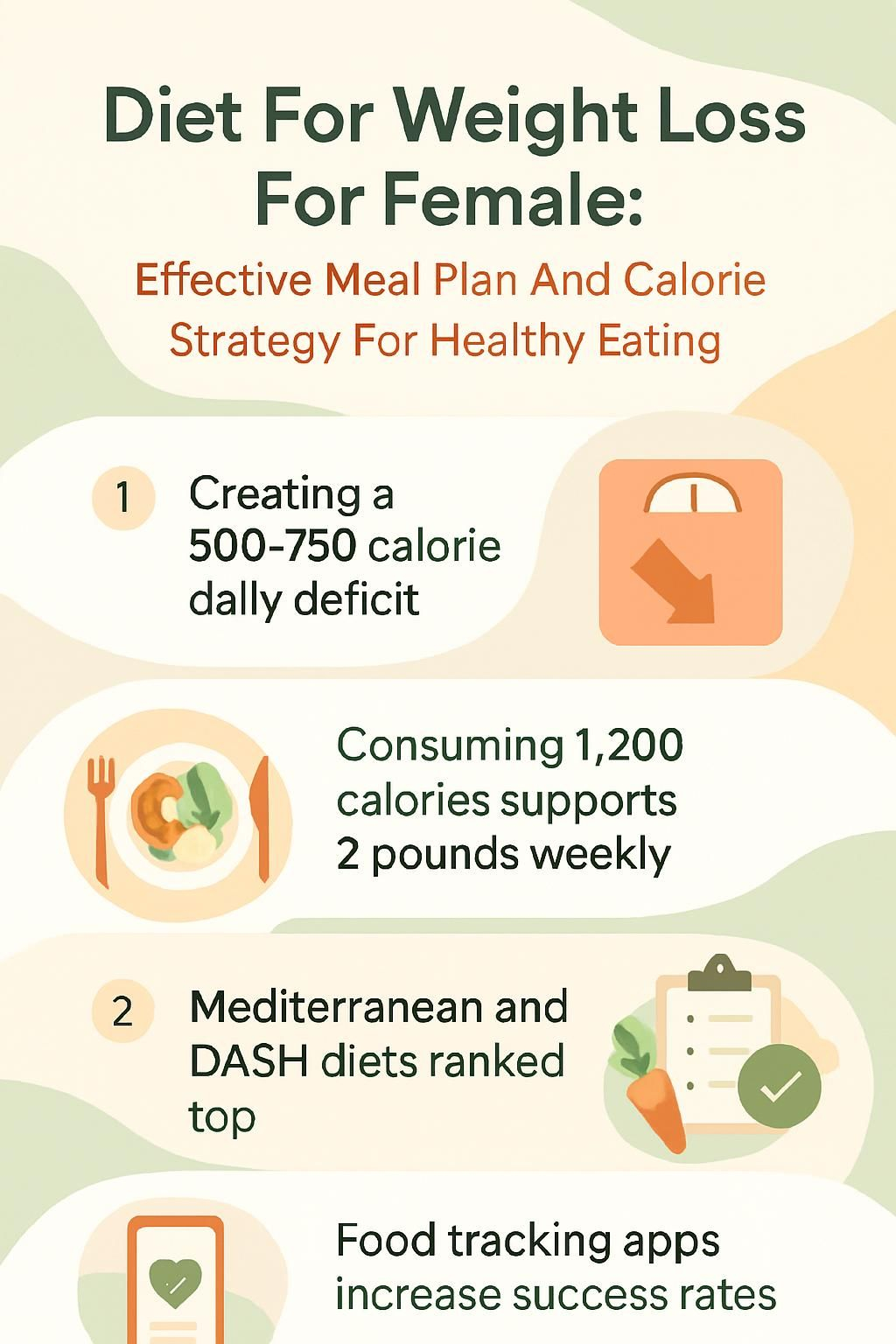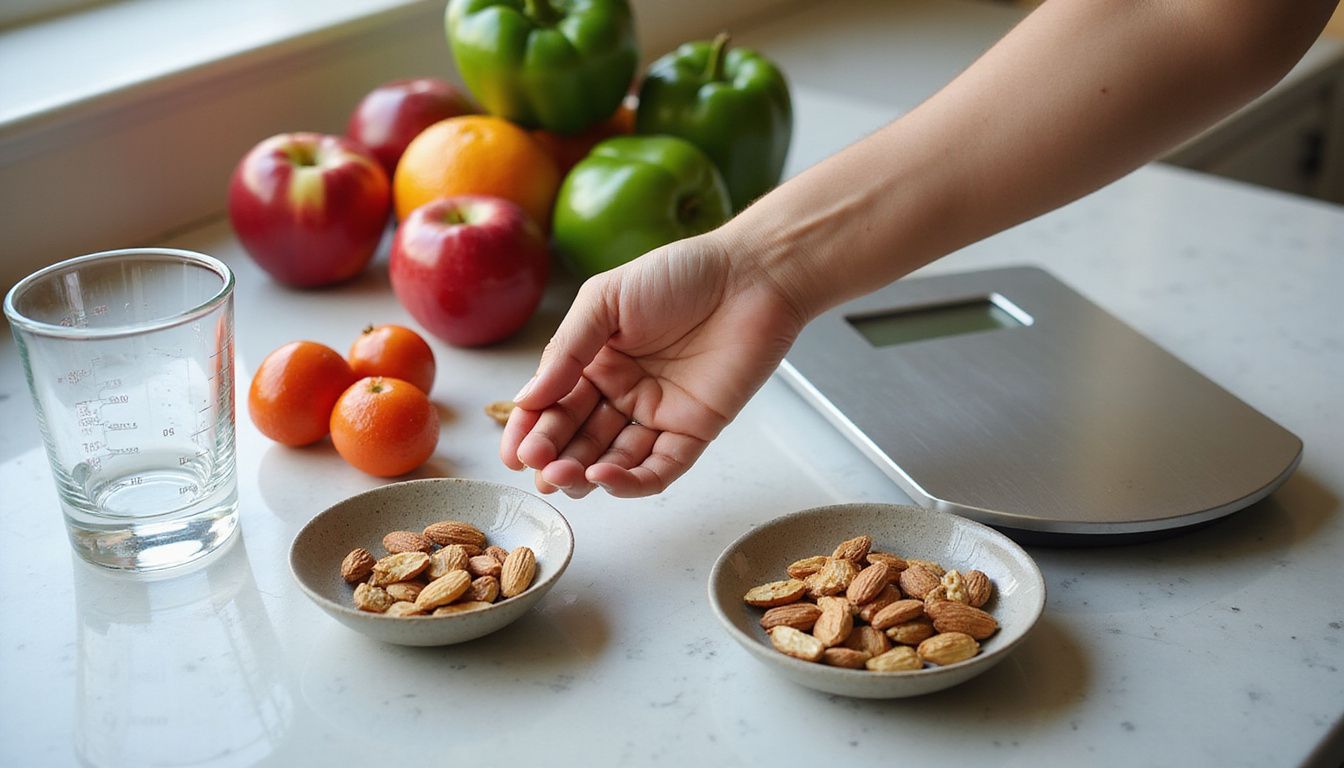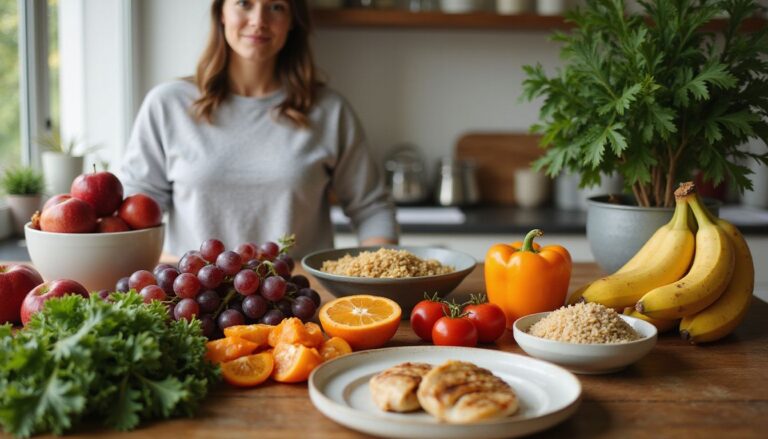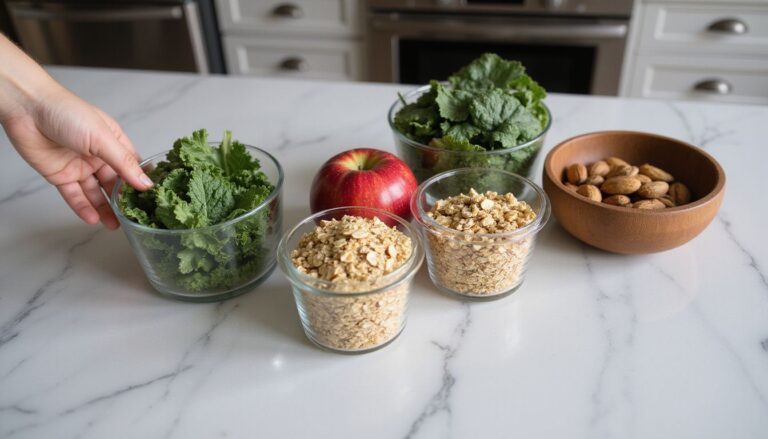Diet For Weight Loss For Female: Effective Meal Plan And Calorie Strategy For Healthy Eating
Our Nutrition Assistant AI Suite will transform your body. You will lose fat, get toned, and build muscle. Gain confidence and optimal health.
Struggling to lose weight and keep it off can feel exhausting. A smart diet for weight loss uses healthy eating, a simple meal plan, and steady calorie control so progress lasts.
This guide gives you an easy plan you can follow, clear diet strategy tips, and ideas consistent with expert advice from sources such as the Mayo Clinic. Use it to build habits that support long-term weight management.
Start here, then make small changes you can keep for life.
Key Takeaways
- Creating a daily calorie deficit of about 500 to 750 calories remains the most reliable way to lose weight, as shown in the DIETFITS trial in 2018.
- A balanced 1,200-calorie meal plan with fiber, lean protein, healthy fats, and whole grains can support steady loss of up to two pounds per week.
- The Mediterranean Diet and DASH Diet rank highly with U.S. News & World Report and the Mayo Clinic for heart health and sustainable results in women.
- Tracking food with apps such as MyFitnessPal or Lose It! improves consistency. Research links journaling with higher long-term success.
- Portion tactics like smaller plates help you eat fewer calories without more hunger, which matches Mayo Clinic Lose It! phase guidance.

Key Principles for a Weight Loss Diet

Healthy eating patterns make weight loss easier and help you keep results. A balanced plan gives your body what it needs while keeping total calories under control.
Why is a calorie deficit important for weight loss?
Weight loss happens when you eat fewer calories than you burn. That gap is called a calorie deficit. Your body then uses stored fat for energy.
Research shows the deficit itself drives results. In the DIETFITS study, people lost similar weight on low-fat or low-carb plans when total calories were matched (Gardner et al., 2018).
Low-calorie plans often provide 1,000 to 1,500 calories per day, which can create a 500 to 750 calorie daily deficit. Meal replacements like shakes or bars can make this easier and may lead to several kilograms more loss than support-only programs.
“Weight loss requires an energy deficit: you must eat less and move more.”
What are nutrient-dense and high-fiber foods?
Calories matter, but food quality matters too. Nutrient-dense foods pack many vitamins and minerals into fewer calories. High-fiber foods add fullness, which helps you stay within your target.
Great choices include vegetables, fruits, whole grains, beans, nuts, and fish. The Mayo Clinic Healthy Weight Pyramid encourages generous servings of fruits and vegetables because they are low in calories and rich in nutrients.
Aim for 25 to 30 grams of fiber daily. Fiber slows digestion and helps control appetite, which supports healthy blood sugar and heart health. Mediterranean and DASH eating patterns naturally include plenty of fiber.
If you are new to higher fiber, increase slowly. Some gas or bloating may appear at first, then usually improves as your body adapts.
How does hydration affect weight loss and why avoid sugary drinks?
Water supports appetite control and replaces high-calorie drinks. Choose water, unsweetened tea, or coffee to lower daily calories.
Health organizations such as the Mayo Clinic and the American Heart Association suggest plain water as a daily habit. Sugary soda and fruit juice add fast calories and do not help fullness. They can spike blood sugar and raise blood fats in those at risk.
Replacing sugary drinks with unsweetened options helps prevent weight gain and supports steady loss. Make this switch at breakfast, lunch, dinner, and snack times.
Effective Meal Plans for Weight Loss
A thoughtful diet meal plan takes the guesswork out of eating. It helps you choose the right amount of food while keeping nutrition balanced.
What is a balanced macronutrient distribution for weight loss?
Macronutrients are protein, carbohydrates, and fat. A balanced split supports your metabolism and protects muscle while you lose weight.
- Protein: about 30 percent of calories, or 0.8 to 1.2 grams per kilogram of goal body weight.
- Carbohydrates: about 45 to 65 percent of calories, with some plans using 50 to 130 grams per day.
- Fat: about 10 to 30 percent of calories. Choose olive oil, nuts, and fish, and keep saturated fat low.
The Mediterranean Diet uses this balance with fruits, vegetables, whole grains, yogurt, poultry, fish, and limited red meat. It gives steady energy for daily activity and supports long-term progress.
How can portion control and mindful eating help reduce weight?
Portion control prevents calorie creep. Smaller plates can help food look plentiful, which leads to less eating without extra hunger.
Plan meals and snacks, and prep ahead to avoid random grazing. Eat slowly. Notice hunger and fullness cues. Put your fork down between bites. These small actions help you stop at satisfied, not stuffed.
Use a food diary or app to spot hidden calories and learn true serving sizes. Simple, repeatable habits beat strict, short-term diets.
Sample 7-Day, 1,200-Calorie Meal Plan
This 1,200-calorie plan offers structure and variety. Adjust portions for your needs or activity level, and add vegetables if you need more volume for fullness.
What should I eat for breakfast, lunch, and dinner on Day 1?
- Breakfast: ¾ cup bran flakes, 1 sliced banana, and 1 cup fat-free milk. High fiber plus protein without many calories.
- Lunch: Mini whole-wheat pita with 3 ounces turkey breast, half a roasted pepper, lettuce, 1 teaspoon mayonnaise, mustard, and 1 part-skim mozzarella stick. Add two kiwis. You can swap for a veggie niçoise pita, about 290 calories.
- Dinner: 4 ounces zesty lemon-herb white fish under 200 calories, 1 cup cooked couscous, and 1 cup steamed broccoli.
- Dessert: One single-serve ice cream to stay within your limit.
- Keep meals nutrient-dense and practice portion control. A 1,200-calorie target may lead to up to 2 pounds per week with regular activity.
- Drink water throughout the day instead of sugary drinks.
Day 2 continues with simple, satisfying meals that support a calorie deficit.
What are the meal options for Day 2’s breakfast, lunch, and dinner?
- Breakfast: Smoothie with 1 cup frozen berries, half a banana, and 8 ounces milk. Add 1 to 2 hard-boiled eggs for protein.
- Lunch: 1 cup vegetable soup plus a veggie burger on whole grain toast or an English muffin. Finish with 1 cup grapes.
- Dinner: Barbecue-style cutlets with citrus slaw. For a plant-forward swap, sauté spinach with garlic, olive oil, and tomatoes, then add half a baked sweet or white potato.
- Each meal balances protein, fiber, and healthy fats to reduce hunger and aid weight management.
The next day follows the same simple structure, which helps you stay consistent.
What does Day 3’s 1,200-calorie meal plan include?
- Breakfast: ½ cup oats with low-fat or soy milk, topped with ½ sliced apple, 1 teaspoon honey, and cinnamon.
- Lunch: Chicken salad with 4 ounces cooked chicken breast, ¼ cup grapes, 1 tablespoon almonds, ¼ cup chopped celery, mixed with 1 tablespoon mayonnaise and 1 tablespoon Greek yogurt. Serve over lettuce with one slice multigrain toast.
- Dinner: 4 ounces steamed shrimp, 1 baked potato with 3 tablespoons salsa and 1 tablespoon Greek yogurt, plus 3 cups raw spinach.
- Dessert: 1 ounce chocolate or an ice cream bar, about 100 to 150 calories.
- Use Greek yogurt and almonds for extra protein and healthy fat to control hunger.
- Pick whole grains like oats or multigrain bread for better fullness and heart health.
- Include at least three servings of vegetables for fiber and digestion.
- Drink water often. Skip sugary drinks that add hidden calories.
- Use smaller plates to manage portions.
- Log your meals. Consistent tracking supports long-term success.
- This approach reflects evidence that lean protein and high-fiber produce fit well within effective calorie strategies.
What meals are suggested for Day 4?
- Breakfast: 1 cup Greek yogurt with 1 cup fresh berries for protein and fiber.
- Lunch: 1 cup tomato soup and a mini whole-wheat pita with 3 ounces roast beef, 1 teaspoon horseradish, mustard, tomatoes, and lettuce.
- Snack with lunch: 2 cups raw veggies, such as carrots and cucumbers, plus ¼ cup hummus.
- Dinner: 4 ounces poached salmon, slaw made from 1¼ cups coleslaw mix, 2 scallions, 1 tablespoon rice vinegar, and 1½ teaspoons olive oil, plus 1 cup cooked quinoa.
- Greek yogurt, roast beef, and salmon provide protein for muscle while you lose fat.
- Vegetables, berries, quinoa, and soup boost fiber and satiety.
- Olive oil and salmon add healthy fats that support heart health.
- Varied flavors and textures help you stay satisfied without extra calories.
- Many people find this mix reduces cravings for sweets and soda.
Balanced macronutrients make these days easier to follow, which helps results stick.
What is the Day 5 meal plan for weight loss?
- Breakfast: 1 cup Cheerios with ½ cup berries. Add 1 tablespoon almonds and 6 ounces Greek yogurt for protein and healthy fat.
- Lunch: Mushroom quesadillas with cucumber spears. Include ½ cup cottage cheese or more Greek yogurt for extra protein.
- Fruit: Two clementines for vitamin C, fiber, and natural sweetness.
- Dinner: Pork tenderloin in a balsamic, honey, and thyme sauce, about 370 calories per serving.
- Side: Roasted butternut squash for fiber and slow-digesting carbs.
- Add nuts like almonds to support fullness across the day.
- Use dairy such as Greek yogurt or cottage cheese to help preserve muscle.
- Fill half your plate with vegetables for volume, nutrients, and fewer calories.
- Track calories to stay near 1,200 for the day.
These choices pair well with several popular diet styles.
What meals make up Day 6’s plan?
- Breakfast: 1 whole-grain waffle with 2 tablespoons nut butter, banana slices, cinnamon, and nutmeg; plus 8 ounces fat-free milk.
- Lunch: Tuna salad made with low-fat mayo and nonfat yogurt, about 135 calories per serving. Add 10 baby carrots, two-thirds cup Greek yogurt, and a small pear.
- Dinner: Spicy sausage jambalaya. Sauté 3 cups spinach with garlic in 1 tablespoon olive oil.
- Drink water regularly to support your calorie deficit.
- Choose low-fat dairy at breakfast and lunch for protein and calcium.
- Use spices to add flavor without sugar or extra salt.
- Load up on vegetables like spinach and carrots for vitamins and fullness.
- This day follows many Mediterranean Diet principles, such as plant-forward meals and healthy fats.
These meals fit within about 1,200 calories, which supports weight loss in many women.
What should I eat on Day 7 for weight loss?
- Breakfast: Half an English muffin, 1 ounce reduced-fat cheese, 1 sliced tomato, 1 cup spinach, a poached egg, and 1 grapefruit. Balanced protein, produce, and fiber.
- Lunch: Black bean salad with half a cup beans, oranges, peppers, onions, scallions, and vinegar over greens. Add 1 corn tortilla and fresh fruit.
- Snack: Raw veggie sticks or a small handful of nuts to control afternoon hunger.
- Dinner: Grilled chicken or baked fish with roasted broccoli and brown rice.
- Hydration: Aim for about eight cups of water. Skip sugary drinks to lower risk for heart disease and stroke.
- Portion control: Use smaller plates and measure servings when possible.
- Plan ahead: Prep meals or track calories to keep the day near 1,200.
Understanding how different diet styles work can help you pick the habits you will keep.
Types of Popular Weight Loss Diets
Several diet styles can help you manage obesity and lose excess weight. The best plan is the one you can follow.
What is the Mediterranean Diet?
The Mediterranean Diet centers on fruits, vegetables, beans, nuts, whole grains, yogurt, poultry, and fish. Olive oil is the main fat. Red meat is eaten in small amounts.
Major organizations endorse this pattern for health and weight management. It often leads to greater weight loss than low-fat eating at 12 months and improves cholesterol and blood pressure (U.S. News & World Report; Mayo Clinic).
Meals feel satisfying because of fiber and healthy fats, which makes portion control easier. Many people pair it with regular walks or simple time-restricted eating for extra structure.
How does a High-Protein Diet support weight loss?
Higher protein increases fullness and protects muscle while you cut calories. A common target is 1.2 to 2 grams of protein per kilogram of goal body weight, or about 30 percent of calories.
Use a mix of sources: fish, poultry, eggs, beans, soy, and nuts. If you have kidney disease or diabetes, talk with a clinician before raising protein.
Some low-carb plans also raise protein and fat. You still need vegetables, fiber, and healthy fats for balance and safety.
What is a Low-Carbohydrate Diet?
Low-carb plans limit daily carbohydrates below the usual 45 to 65 percent of calories. Some aim for 50 to 130 grams per day. Ketogenic versions go even lower, often below 20 to 50 grams.
These plans may help people with type 2 diabetes manage blood sugar and heart risk factors. Very low-calorie ketogenic diets, around 700 to 800 calories per day, require medical supervision and are not appropriate for pregnancy, type 1 diabetes, or kidney failure.
Plan meals around lean protein, nonstarchy vegetables, and healthy fats. Weight loss can be quick early on, but results level off without consistent habits.
What are the benefits of the DASH Diet?
DASH stands for Dietary Approaches to Stop Hypertension. It is rich in fruits, vegetables, whole grains, and low-fat dairy. Sodium stays below about 2,300 milligrams per day.
Clinical research shows DASH lowers blood pressure and supports heart health. It can also aid weight loss and reduce abdominal fat when paired with calorie control.
Many patients use DASH after bariatric surgery or during postpartum recovery because it is balanced and practical.
How do Plant-Based and Vegetarian Diets aid in weight loss?
Vegetarian patterns cut out meat and poultry. They emphasize vegetables, fruits, whole grains, legumes, nuts, and seeds. These foods are fiber-rich, so they help you feel full on fewer calories.
Studies link plant-based eating with lower risks of heart disease, type 2 diabetes, and some cancers. Weight loss is common because meals are less calorie-dense. Plan for omega-3s with flaxseed, chia, walnuts, or fortified foods.
If you include plenty of soluble fiber, like oats and barley, you can improve cholesterol and appetite control.
Strategies for Calorie Control
Small tools make a big difference. Use simple cues to help your brain and stomach agree on enough food.
How does using smaller plates help control calories?
Smaller plates make portions look larger, which helps you feel satisfied with less food. People tend to eat what they serve, so shrinking dinnerware can reduce intake without more hunger.
The Mayo Clinic Diet includes this tactic in its Lose It! phase because it supports portion awareness and mindful eating.
Many people find that salad-sized plates help them stay near daily calorie targets with less effort.
Why is meal prepping and planning ahead effective?
Prep removes guesswork. When meals are ready, you avoid last-minute choices that add calories.
Planning is linked to better diet quality and long-term adherence. A weekly plan also reduces stress and saves money. Packing lunches on Sunday, for example, makes weekdays easier and helps you skip fast food.
Prepping also helps you meet protein goals and control fats and sodium while staying near 1,200 to 1,500 calories if that is your target.
How can I track calories using apps or journals?
Use a food diary or a calorie app to log meals and snacks. Tools like MyFitnessPal or Lose It! let you search foods, scan barcodes, and track weight and activity.
People who log consistently tend to lose more weight. Review your entries weekly to spot patterns, like frequent sugary drinks or large snacks.
Set simple goals, then adjust as you learn what works for you.
Role of Physical Activity in Weight Loss
Movement supports your calorie deficit and keeps energy high. Think of it as the engine that helps your plan run smoothly.
What are the benefits of moderate-intensity exercise?
Moderate activity, such as brisk walking, cycling, or light resistance work, burns calories and improves heart health. Aim for at least 30 minutes most days.
Regular activity lowers risk for diabetes, high blood pressure, and sleep apnea. It also helps you maintain loss by supporting a healthy metabolism.
Start small if you have been inactive. Add minutes and pace over time to avoid injury.
How should I incorporate strength training and cardio?
Combine both. Strength training builds muscle, which increases calorie burn at rest. Cardio supports heart health and burns calories during the workout.
Alternate days if needed. Try two strength sessions and three cardio sessions per week to start. Keep workouts consistent, then increase intensity as you get stronger.
Recommended Food Choices for Healthy Eating
Smart swaps add up. Focus on foods that fill you up and nourish your body.
Why choose whole grains over refined grains?
Whole grains keep the bran and germ, which provide fiber, vitamins, and minerals. Examples include brown rice, quinoa, oats, and whole wheat bread.
Fiber helps control appetite and lowers the total calories you eat. The Dietary Guidelines for Americans suggest making at least half your grains whole grains.
Regular whole grain intake also supports better metabolic health and long-term weight management.
What are good lean protein options for weight loss?
Choose turkey breast, shrimp, white fish, salmon, and pork tenderloin. These provide high-quality protein with fewer calories from fat.
Beans and lentils are strong plant options that add fiber. Mix animal and plant proteins to reach the daily protein goal for women, about 46 to 56 grams, or more if your plan calls for it.
Grilled seafood salads or stir-fries with beans can keep you full without overshooting calories.
Which healthy fats should I include in my diet?
Pick olive oil, avocados, nuts, and seeds. Fatty fish like salmon and sardines provide omega-3s, which support heart health.
Many people do well keeping dietary fat near 15 to 20 percent of daily calories during weight loss. Plant-based eaters can use flaxseed, chia, walnuts, or algae-based supplements to meet omega-3 needs.
Use a measured tablespoon of olive oil to cook vegetables for flavor without excess calories.
How many fruits and vegetables should I eat daily?
Aim for at least five servings of fruits and vegetables each day. More is welcome, especially nonstarchy vegetables like leafy greens, broccoli, and peppers.
Color variety means a wider mix of nutrients and antioxidants. If you manage blood sugar, focus more on vegetables and choose whole fruits over juice.
Keep washed produce visible and ready. It makes healthy snacking easier.
Meal Timing and Intermittent Fasting
Meal timing gives your day a simple rhythm. That rhythm can reduce snacking and help you keep a calorie deficit.
Why is maintaining a regular meal schedule important?
Regular meal times support steady energy, better appetite control, and consistent calorie intake. Irregular eating is linked with higher obesity risk.
Plans from groups like the Mayo Clinic show that routines support long-term success. Set times for meals and snacks, then stick to them most days.
Calendar reminders in your app can help you keep that routine without stress.
What are the benefits of time-restricted eating?
Time-restricted eating limits food to a daily window, such as 8 hours. Many people find it cuts mindless snacking and makes calorie control easier.
Studies show it may improve insulin sensitivity and blood sugar control. Fasting periods encourage the body to use stored fat for energy.
Keep the eating window consistent, choose nutrient-dense foods, and drink water or unsweetened beverages outside the window.
Practical Tips for Sustained Weight Loss
Simple, repeatable actions beat complex rules. Aim for steady wins you can maintain.
How can I avoid fad diets and quick fixes?
Skip plans that ban entire food groups or promise rapid results. Build a balanced plate with fruits, vegetables, whole grains, lean protein, and healthy fats.
Use a kickstart phase to build momentum, then shift to a maintenance phase. Add at least 30 minutes of daily activity to support your plan.
If you have medical conditions, ask a healthcare professional to help you set safe calorie targets.
What are effective ways to stay consistent with healthy habits?
Set realistic goals you can reach this week. Plan meals, prep ahead, and keep portions in check. These steps reduce last-minute choices that add calories.
Track food and activity to stay accountable. Many people find smaller plates help them eat less without feeling deprived. Prepping three days of lunches often prevents takeout during busy weeks.
Choose habits that match your schedule and preferences so they last for months, not days.
How do I maintain motivation and set achievable goals?
Pick clear goals, such as a 1,000 to 1,500 calorie range, if that fits your needs. Keep your plate full of nutrient-dense foods to manage hunger.
Check progress weekly, then adjust portions or activity if loss slows. Share your goals with a supportive friend or group.
Celebrate small wins, like hitting your water goal or cooking at home all week. These moments build momentum.
Potential Risks and Health Considerations
Safe weight loss protects your health while the scale moves. Get medical advice if you have conditions or take medications.
What are the risks of overly restrictive diets?
Very low calorie intake or cutting entire food groups can cause nutrient gaps. Signs may include fatigue, hair loss, brittle nails, and bone weakness.
Extreme restriction can slow metabolism and lead to weight cycling. Strong cravings may trigger overeating, which is discouraging and hard to manage.
A balanced plan helps you avoid these traps and supports steady progress.
When should I consult a healthcare provider before starting a diet?
Talk with a clinician if you have diabetes, heart disease, kidney problems, or any chronic illness. Medical guidance is essential for very low-calorie diets and ketogenic plans.
Pregnant people and older adults with frailty should avoid restrictive plans. If you take medications, changes in diet may require dose adjustments.
Regular check-ins improve safety, track progress, and keep your plan on course.
Conclusion
A clear diet strategy, a simple meal plan, and steady calorie control make weight loss realistic. Focus on nutrient-dense foods, portion awareness, and regular physical activity.
Patterns such as the Mediterranean Diet or DASH show you can eat well and still lose weight. A 1,200-calorie framework can teach portion sizes while keeping meals enjoyable.
Choose whole grains, lean protein, fruits and vegetables, plus healthy fats. Keep habits consistent and adjust as life changes. If you have health concerns, consult your healthcare provider before starting. Healthy eating supports long-term weight management and a better quality of life.
FAQs
1. What is an effective meal plan for weight loss in women?
An effective meal plan for female weight loss includes lean proteins, whole grains, vegetables, and healthy fats. Studies show that balanced meals with controlled portions help manage hunger and support steady fat reduction. For example, a typical day might include oatmeal with berries at breakfast; grilled chicken salad at lunch; salmon with quinoa and broccoli at dinner; and fruit or yogurt as snacks.
2. How many calories should women eat daily to lose weight safely?
Most adult females can aim for 1,200 to 1,500 calories per day to promote gradual fat loss while preserving muscle mass. Research from the National Institutes of Health suggests reducing daily intake by 500 calories leads to about one pound lost each week. Individual needs may vary based on age, activity level, height, and health status.
3. Which foods should be limited or avoided during a calorie strategy for healthy eating?
Limit processed foods high in sugar or saturated fat such as pastries, chips, soda drinks, fried items like French fries or doughnuts; these add extra calories without nutrients. Evidence links excessive consumption of these items to higher body mass index scores among women seeking weight management.
4. Can personal experience improve success with diet changes?
Yes; keeping a food journal helps track habits and identify patterns that affect progress toward goals. Many people find sharing their journey with friends increases accountability and motivation over time.
Summary: A structured approach using evidence-based meal planning supports safe calorie reduction in women aiming for sustainable weight control outcomes.







